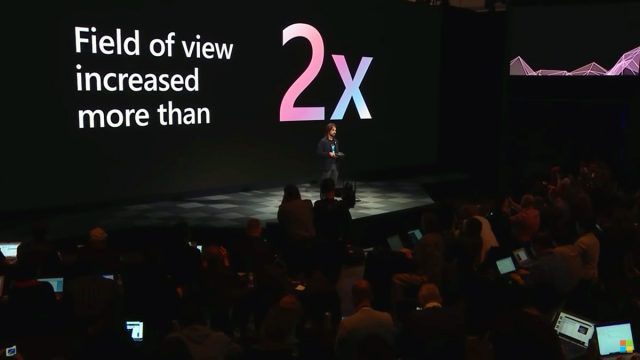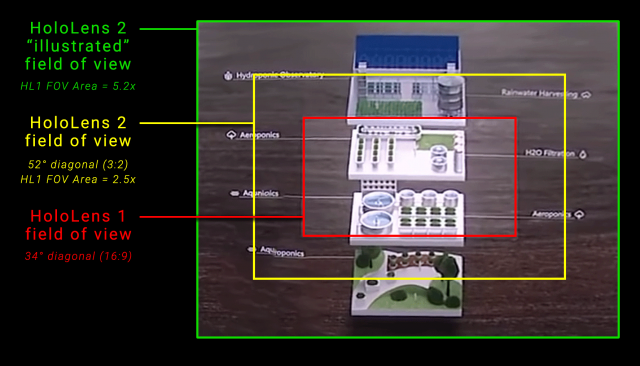To significant anticipation, Microsoft revealed HoloLens 2 earlier this week at MWC 2019. By all accounts it looks like a beautiful and functional piece of technology and a big step forward for Microsoft’s AR initiative. All of which makes it unfortunate that the company didn’t strive to be clearer when illustrating one of the three key areas in which the headset is said to be improved over its predecessor.
On stage this week at MWC 2019, HoloLens visionary Alex Kipman was the one to officially reveal HoloLens 2. The headset, he said, delivers improvements in three key areas that customers of the original headset had consistently asked for: field of view, comfort, and business ROI right out of the box.
For field of view—how much of your view is covered by the headset’s display—Kipman said that HoloLens 2 delivers “more than double” the field of view of the original HoloLens.
“More Than Double” …What, Exactly?

Within the AR and VR markets, the de facto descriptor used when talking about a headset’s field of view is an angle specified to be the horizontal, vertical, or diagonal extent of the device’s display from the perspective of the viewer. When I hear that one headset has “more than double” the field of view of another, it says to me that one of those angles has increased by a factor of ~2. It isn’t perfect by any means, but it’s how the industry has come to define field of view.
It turns out that’s not what Kipman meant when he said “more than double.” I reached out to Microsoft for clarity and found that what he was actually referring to was not a field of view angle, rather the field of view area, but that wasn’t explained in the presentation at all, just (seemingly intentionally) vague statements of “more than twice the field of view.”
But ok… I get it. Field of view area isn’t a bad way to compare headsets by any means, if somewhat peculiar compared to how other companies rely this information. Not the end of the world.
But then Kipman moved onto a part of the presentation which visually showed the difference between the field of view of HoloLens 1 and HoloLens 2, and that’s when things really became misleading.
From 2x to 5.2x
In the center of the image Microsoft showed the HoloLens 1 field of view, and then drew out the edges of the image to show how much larger the HoloLens 2 field of view was by comparison. Except it was hugely exaggerated.
I pulled the below photo right from the presentation and used a perspective-correct transformation to make sure the shapes are correct relative to the camera angle. Then I overlaid the actual HoloLens 2 field of view (since confirmed to me by Microsoft) as it should have been sized in the comparison:

The difference between the actual field of view and what was presented is not just a little bit wrong… it’s like, way wrong. Microsoft made a big deal about the “more than double” increase (in area) compared to HoloLens 1, but managed to misrepresent the difference by an even larger margin, showing a 5.2 times area increase over HoloLens 1 in the visual.
What makes this even more unfortunate is that they attempted to show how the wider field of view would let you see more of a virtual object, but the actual HoloLens 2 field of view in this case would have truncated the example on all sides.
When I asked Microsoft about this, I was told that what was shown just an “illustration,” and only a brief part of the presentation. But it seems surprising that they didn’t take more care to faithfully represent one of the headset’s most important improvements, especially considering this is the only means of comparison short of actually having a HoloLens 1 and 2 in front of you to try.
Initially when I went asking through official Microsoft press channels for specifics on the HoloLens 2 field of view, I was told that “more than double” HoloLens 1 is all the information that would be shared for the time being. When I took to Twitter to air my frustration at the lack of clarity (especially considering that the stated “more than double” was relative to the HoloLens 1 FOV which Microsoft had also been coy about sharing) Alex Kipman responded by pointing to a huge Wired pre-reveal feature article published this week where he confirmed a 34 degree diagonal field of view (16:9) for the original headset, and a 52 degree diagonal (3:2) for HoloLens 2.
But even in an in-depth pre-reveal briefing, Microsoft still didn’t manage to accurately convey the field of view message; the Wired piece reports that the “diagonal field of view has more than doubled” on HoloLens 2—the same thing most people reasonably thought when the company said it on stage this week.
Fool Me Once
This isn’t the first time that Microsoft has been called out for doing a poor job of representing the HoloLens field of view. When the original headset was revealed back in 2015, the company used (admittedly very cool) mixed reality compositing to show a third-person perspective of all the virtual objects floating around the user. This was billed as ‘what the user sees,’ but left out the important detail that with such a small field of view there is significant truncation that is not shown. Microsoft later began adjusting many of its HoloLens marketing visualizations to be more clear about what how the user-perspective actually looked and was impacted by the field of view limitations.
– – — – –
To be clear, this isn’t the end of the world. Companies try to present their products in the best light, and oftentimes that involves stretching the truth. It isn’t clear if Microsoft was being intentionally misleading, or if someone just made a bad mockup, but it does mean that if the only thing you saw was the HoloLens 2 reveal presentation, the field of view is actually significantly smaller than what was shown on stage (and for anyone curious, nearly identical in size to that of Magic Leap).
This will be forgotten in time; HoloLens 2 will go on to do great things. But misrepresenting the field of view doesn’t make it bigger, and people are still going to be asking for even more field of view from HoloLens 3 and beyond. So in the meantime, Microsoft, why not just aim for accuracy and let the device speak for itself.







